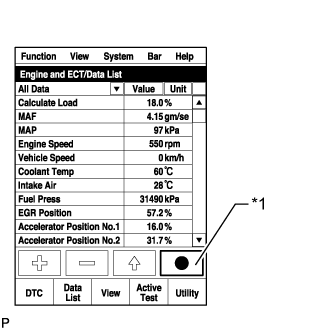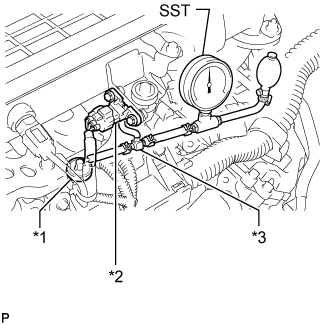Intake System -- On-Vehicle Inspection |
| 1. CHECK INTAKE AIR CONTROL SYSTEM |
Check for leakage or clogging between the air cleaner housing and inlet turbocharger and between the outlet turbocharger and cylinder head.
Condition Operation Clogged air cleaner Replace element Hoses collapsed or deformed Repair or replace Leakage from connections Check each connection and repair Cracks in components Check and replace
| 2. CHECK EXHAUST SYSTEM |
Check for leakage or clogging between the cylinder head and turbocharger inlet and between the turbocharger outlet and exhaust pipe.
Condition Operation Deformed components Repair or replace Foreign material in passages Remove Leakage from components Repair or replace Cracks in components Check and replace
| 3. CHECK AIR INDUCTION SYSTEM |
- HINT:
- The illustration shows the areas that may draw in secondary air, which could lead to idling problems.
Check that the hoses, gaskets, clamps and O-rings are installed correctly.
Check for cracks, etc. in the hoses, gaskets and O-rings.
- for V-bank Outside Area:

Text in Illustration *A w/ Intercooler - - 
Text in Illustration *A w/o Intercooler - -
- for V-bank Inside Area:

Text in Illustration *A w/ EGR System - - 
Text in Illustration *A w/o EGR System *B w/ Intercooler *C w/o Intercooler - -
- for V-bank Outside Area:
| 4. CHECK BOOST PRESSURE |
Connect the intelligent tester to the DLC3.
Start the engine and turn the tester on.
Warm up the engine.
- HINT:
- Be sure to perform the inspection when the engine coolant temperature is between 75 and 90°C (167 and 194°F).
Enter the following menus: Powertrain / Engine / Data List / VN Turbo.
Take a snapshot of the Data List items with the intelligent tester shown in the illustration.
Text in Illustration *1 Snapshot Record Button - HINT:
- Graphs can be displayed by transferring the stored snapshot from the tester to a PC. Intelligent Viewer must be installed on the PC.
- The condition of the turbocharger can be determined by fully depressing the accelerator pedal while driving at 15 km/h (9 mph) in 2nd gear to accelerate the vehicle (obey all laws and regulations, and pay attention to driving conditions while driving the vehicle), and then comparing MAP with Target Booster Pressure at an engine speed of 3000 rpm.
 |
Compare MAP with Target Booster Pressure.
- Standard:
- MAP is within 35 kPa of Target Booster Pressure when accelerating with accelerator pedal fully depressed.
- HINT:
- The specification above denotes the difference between the absolute pressure values.
- The inspection above is only for vehicles equipped with a manual transmission.
- If the driving inspection using the intelligent tester above cannot be performed (e.g. due to road conditions), perform the following inspection.
Warm up the engine.
- HINT:
- Be sure to perform the inspection when the engine coolant temperature is between 75 and 90°C (167 and 194°F).
Using a 3-way connector, connect SST (turbocharger pressure gauge) between the diesel turbo pressure sensor (manifold absolute pressure sensor) and the gas filter.
- SST
- 09992-00242
Text in Illustration *1 Gas Filter *2 Diesel Turbo Pressure Sensor *3 3-Way Connector Fully apply the parking brake and chock the 4 wheels.
for Manual Transmission:
While depressing the clutch pedal, fully depress the accelerator pedal. Measure the boost pressure at maximum engine speed (4700 to 4900 rpm).for Automatic Transmission:
Move the shift lever to P or N, and then fully depress the accelerator pedal. Measure the boost pressure at maximum engine speed (4700 to 4900 rpm).- Standard Pressure (Gauge Pressure):
- 30 to 60 kPa (0.30 to 0.61 kgf/cm2, 4.3 to 8.7 psi)
- The intake system or exhaust system has leakage or blockage.
- w/ DPF:
The turbocharger sub-assembly or ECM is malfunctioning. - w/o DPF:
The turbocharger sub-assembly or turbo motor driver is malfunctioning. - The EGR valve does not close.
- The diesel throttle body does not open.
- The vacuum hose connected to the diesel turbo pressure sensor (manifold absolute pressure sensor) is cracked or disconnected.
- The mass air flow meter is malfunctioning.
- A fuel injector is malfunctioning.

Chart showing the suspected trouble areas when the pressure is lower than the standard.
- HINT:
- ○: If a problem listed in the leftmost column of the chart exists, or if the part in the leftmost column of the chart has a malfunction, the value of the Data List item in the uppermost row of the chart will meet the conditions shown in the row labeled "Value which represents a malfunction".
- The values in the chart are applicable when the engine coolant temperature is between 75 and 90°C (167 and 194°F).
- The values in the chart are for vehicles equipped with a manual transmission. For vehicles with an automatic transmission, use these values as a reference only as they may differ from the actual values.
- The values in the chart are valid in an area with an absolute atmospheric pressure higher than 95 kPa. (Standard atmospheric pressure is 101 kPa. Atmospheric pressure decreases by 1 kPa for every 100 m increase in altitude, and is also affected by the current weather conditions.)
- When the altitude increases, atmospheric pressure and MAP decrease.
Item MAP
(Absolute pressure inside intake manifold)MAF
(Intake airflow rate)Accel Position Actual Throttle Position (#1, #2) Actual EGR Valve Pos. (#1, #2) EGR Close Lrn. Status (#1, #2)
(EGR valve fully closed position learning status)w/o DPF:
Fuel Press
w/ DPF:
Common Rail PressureInjection Feedback Val #1 (to #8) Values taken from an actual normal vehicle
*1- 228 g/sec. 99% or more w/o DPF:
0%0% w/o DPF:
OK- -3 to +3 mm3/st w/ DPF:
100%w/ DPF:
-Values which represent a malfunction
*1MAP is below Target Booster Pressure by 35 kPa or more MAF is less than 190 g/sec. Accel Position is not fully depressed position
*2Actual Throttle Position (#1, #2) is not within 10% of Target Throttle Position (#1, #2) Actual EGR Valve Pos. (#1, #2) is more than 10%
*3w/o DPF:
NG
(Determined after performing learning)Fuel Pressure is below Target Common Rail Pressure by 10 MPa or more (Check while condition steady) Outside of above range w/ DPF:
-Turbocharger ○ ○ - - - - - - EGR valve does not close or has problem with movement ○ ○ - - ○
(Problem with EGR valve movement)
*4, *5○
(EGR valve does not close)
*4, *5- - Problem with diesel throttle movement ○
(Intake airflow decreases)○ - ○ - - - - Accelerator pedal cannot be fully depressed or problem with accelerator pedal position sensor exists - ○ ○ - - - - - Intake air system leakage or blockage ○ ○ - - - - - - Exhaust gas leakage before turbocharger or blockage ○ ○ - - - - - - Manifold absolute pressure sensor ○ ○ - - - - - - Manifold absolute pressure sensor hose is disconnected ○ ○ - - - - - - Mass air flow meter sub-assembly - ○ - - - - - - Fuel system (injector, supply pump or common rail) ○ ○ - - - - ○
(Fuel injector leakage, decrease in pressure discharge valve relief pressure or valve is stuck)○
*6- HINT:
- *1: These values are measured when the transmission is in 2nd gear, the accelerator pedal is fully depressed, the vehicle is accelerating, and the engine speed is 3000 rpm.
- *2: The Accel Position is the accelerator opening angle (%) for engine control use. The value indicates around 100% when the accelerator pedal is fully depressed. If the value does not indicate around 100% when the accelerator pedal is fully depressed, the accelerator pedal position sensor circuit or the pedal itself is malfunctioning. When the MIL is illuminated, even with the accelerator pedal fully depressed and an Accel Position of below 70%, it means the fail-safe is restricting the accelerator.
- *3: Check that the Actual EGR Valve Pos. is always following the Target EGR Position value (e.g. the Actual EGR Valve Pos. is around the fully closed position when the Target EGR Position value indicates 0%). The EGR valve may be malfunctioning if the value is stuck or does not fluctuate smoothly. However, in some cases the EGR valve may be malfunctioning even if the Actual EGR Valve Pos. value is normal. Inspect the EGR valve for any defects (deposits, valve stuck, poor movement, etc.) if necessary.
- *4: w/ DPF
DTC P0400 (Bank 1, Bank 2) or P042E (for Bank 1) or P045E (for Bank 2) may be stored at this time. If the actual EGR valve position follows the target EGR valve position slowly, a feeling of hesitation may occur. - *5: w/o DPF
DTC P0400 (for Bank 1) or P1248 (for Bank 2) may be stored at this time. If the actual EGR valve position follows the target EGR valve position slowly, a feeling of hesitation may occur. - *6: If Injection Feedback Val # of a cylinder is not within -3 to +3 mm3/st, the corresponding cylinder may have a malfunction (injector or compression). However, in some cases the cylinder may be malfunctioning even if the value is within -3 to +3 mm3/st because these values are injection volume correction values calculated by the ECM during engine idling and not correction values for the high engine load condition related to boost pressure control and engine output performance.
| 5. CHECK TURBOCHARGER SUB-ASSEMBLY |
- CAUTION:
- Wear protective gloves to prevent injuries and burns when checking the turbocharger.
- The engine compartment becomes hot when the engine is running.
Make sure that the DC motors connector is properly connected.
Check the motor movement when turning the ignition switch to ON, when starting the engine, and then when turning the ignition switch off.
If the result is not as specified, check the ECM (w/ DPF: Click here, w/o DPF: Click here) and/or turbo motor driver (w/ DPF: Click here, w/o DPF: Click here).Text in Illustration *a Ignition switch ON *b Engine idling *c *b → *c → *d:
Turn the ignition switch off at idling*d Ignition switch off
 |